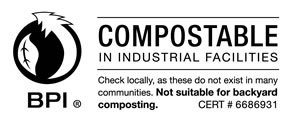What's the difference between can liners vs trash bags? It's a matter of semantics. For the most part, homeowners use the term "trash bag", while companies tend to use "can liners."
In reality, they all refer to the same solution. While there may be no difference between trash cans vs can liners, there are other differences that require more of a discussion. Let's take a closer look at some of the top FAQs regarding can liners and trash cans.
High Density vs Low-Density Trash Bags
Most trash bags and can liners are made from plastic resin, and there are two broad categories of resins:
High-density resin
Low-density resin.
The basic difference between the two types of resins boils down to the process of making polyethylene (plastic) from ethylene gas. The material will have either a high-density or low-density based on the introduction to pressure and heat.
High-Density Trash Can Liners
When polyethylene is exposed to lower temperatures and lower pressure, the molecules will stay more tightly bound together. This creates a higher-density bag that is strong, stiff, and can hold a lot of weight.
At the same time, these bags are thinner and not ideal for jagged or sharp objects. HD trash can liners are less puncture-resistant and thinner. These bags are an economical choice for bathroom trash and office bins.
A bonus of HD can liners is that they are very temperature resistant and fight odor well, which is why they are regularly used as grocery store carryout bags. A few key highlights of HD can liners include:
Excellent for light-duty uses
Can be more cost-efficient
Will tear when encountering sharp objects
Not stretchable and are stiffer
Can carry more weight
Thinner
Ideal for tissues, paper, and some food
Low-Density Trash Bags
When polyethylene is exposed to higher temperatures, the molecules become less dense, branch out, and create a low-density bag. These bags have higher puncture resistance, are thicker, more flexible, and are more suitable for pointy objects. A few key highlights of low-density bags are:
High puncture resistance
Thicker
Holds less weight
More flexible
Perfect for landscaping and construction debris.
Compostable vs Biodegradable Trash Bags
Another common comparison between trash bags and can liners is compostable bags vs biodegradable bags. Most of the confusion surrounding these green bag options can be attributed to false claims and the absence of clear standards in the U.S.
Specifically, many companies claim to offer compostable bags, but these claims are not tested. Furthermore, some manufacturers claim compostable bags that only have a biodegradable additive. Let's take a closer look at compostable bags vs biodegradable bags.
Biodegradable Bags
Biodegradable bags include materials that degrade from organisms that naturally occur in the environment, such as:
Fungi
Algae
Bacteria.
And most biodegradable bags have no time frame associated with the degradation process.
Compostable Bags
Compostable bags, on the other hand, have materials that will degrade at the same rate as other compostable or organic materials. When compostable bags degrade, they leave nothing other than biomass, CO2, water, and other substances that are instrumental to composting.
If you're looking for genuine compostable bags, only those bags meeting the American Society for Testing and Materials (ASTM) D6400 as certified by the Biodegradable Products Institute (BPI) will stand up to these standards. To achieve this certification, the compostable bag must be a minimum of 90% decomposed in 180 days or less.

BioTuf Compostable Trash Bags
The best compostable bags are the BioTuf Compostable bags. Hailed as the "Green Standard", these bags offer a full range of benefits:
Remarkable strength and applicability for pre-consumer and post-consumer food waste diversion programs
Excellent resistance to punctures and tears
Ideal composition for municipal curbside yard waste collection programs
Optimum load capacity and lifting strength
BioTuf Compostable Bags have been repeatedly tested and proven for in-service performance
Gusset Seal vs Star Seal vs Flat Seal
While often overlooked, the seal of your trash bag plays an important role in overall functionality and effectiveness.
Gusset Seals
Gusset seals are created by tucking both sides of the bottom of the bag to form gussets. The gussets are then reinforced with four layers of film at the indented outer edges. Afterward, the outer edges are securely sealed with two layers. Even though these seals have a high tendency for leaks.
Flat Can Liner Seal
Flat seals are made by sealing the bottom edge of the trash bag. These bags are beneficial because they do not sacrifice length, are ideal for being leakproof, and boast the ability to act as a standalone container. However, flat seals do not conform well to the shape of the receptacle.
Star Can Seal
The most common seal used across all industries is the star seal. These seals are created by folding the bottom of the can liner over several times and sealing it. With the star seal, your bag will conform to the trash can's shape while eliminating leaks.
Contact AAA Polymer for Trash Cans and/or Can Liners
At AAA Polymer, we are the leading provider of trash cans and can liners. And our goal isn't to just sell you liners, we want to help you save money by ensuring you're using the best trash bag for the application. We achieve this goal through a tested and proven method of matching your budget, needs, and expectations to the best product.
Contact AAA Polymer today.
